Soccer Royale: Pool Football - Soccer & Pool fusion
Mix soccer and billiards in this addictive sports strategy game!

- 2.3.6 Version
- 4.5 Score
- 4M+ Downloads
- In-game purchases License
- 3+ Content Rating
Introducing Soccer Royale: Pool Football
Participate in this thrilling competitive soccer game that pits you against millions of players! Enjoy an engaging gameplay experience with a diverse cast of characters, unique abilities, and challenging scenarios. Team up with friends to form a club team, create and upgrade your own football squad, and devise winning strategies to dominate the major leagues!
Features:
- Challenge both friends and rivals to exhilarating football matches and earn various rewards.
- Compete against millions of players in weekly leagues, climb the ranks, and acquire stylish cosmetics to showcase your skills.
- Construct your dream team and tailor it to your preferences.
- Embark on an exciting career journey with numerous rewards, unlocking new characters and stadiums along the way.
- Aim to become a solo champion or work together with club members to strategize and overcome challenges, climbing the leaderboards with your friends.
- Experience thrilling matches with unique abilities, physics, and combos that make each game unforgettable.
- Score sensational goals and enjoy multiplayer football matches with your friends!
- An internet connection is necessary to partake in the game.
Every match offers a fun and distinct gameplay experience filled with intense moments with each kick! Customize your team entirely, with each player bringing something different to the table. Enhance your legendary characters and aim for the top. While Soccer Royale's straightforward gameplay provides casual entertainment, the array of characters and spells allows for diverse tactics and intricate gameplay in higher leagues, offering numerous strategic possibilities. Soccer Royale is a fantastic strategy football game to enjoy with friends, as you team up to compete across the globe. Unlock clash heroes for your team, select preferred cards, and strive to become football clash champions!
Please note that Soccer Royale contains in-game items available for purchase with real money. You can disable in-app purchases in your device settings if you prefer not to utilize this feature.
How To Win (almost) Every Game In Youth Soccer (and why you shouldn’t)
Ian Rowe Dec 4, 2021
Losing all the time sucks, but at least it is good to build resilience, and highlights the skills your team needs to work on. Winning is fun, but doing it this way is terrible for your players.
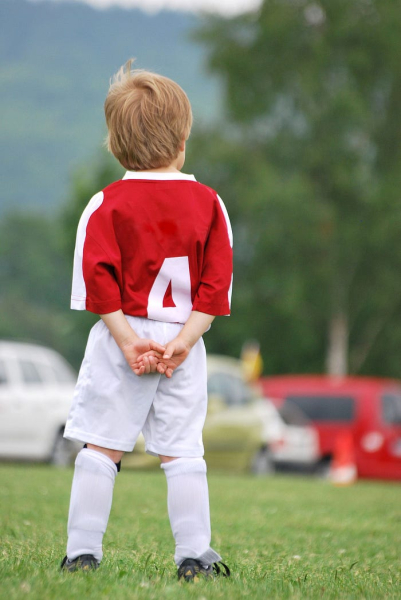
Winning Is Everything?
- Play your best player at Striker or Center Mid for most of the game. Only give them a break when they are tired. (If you have two or three then this applies across all three). Many top players at this level are more fit and can play pretty much the entire game.
- Play your weaker players on the wing, at defence, or in goalie. Keep them in the same positions every game.
- Put a brave kid (ideally with a big kick) who is not confident dribbling in net and keep them there.
- -Focus on kicking the ball far up the field and having your best players recover it to score. For example, goalie or defense sends ball over the heads of the attacking players, striker/centre mid gets the ball once it is past most of the other team. Use their speed and skill to beat any remaining defending players.
Doing this will ruin all of your players (even your best ones) for the rest of their soccer careers, but it will get you wins.
What You Should Coach Instead
Kids (everyone) wants to win. If you are losing every game and can skew it by double shifting a couple key players, do that every once in a while to keep them engaged. Know that it is a trap, and that learning to lose, to be resilient, and to fight back are fundamentally important skills.
Instead Coach teamwork. Coach skills. I have an whole other article about the key things to teach.
Coach dribbling, building from the back, and make sure all kids rotate through positions over a series of games to develop their total soccer ability (dribbling, passing, finishing, defending, decision making, solving soccer problems). Somewhere around eight or nine make sure your keepers learn to play with their feet as part of building from the back.
The point is that, at this level, coaching to win will ruin the sport for many players as they fail to develop basic soccer skills and knowledge.
So don’t coach to win, coach for life.
Soccer tactics explained - offensive and defensive styles of play
What are offensive and defensive soccer tactics? In this article we will explain you how a soccer team can play offensive and defensive soccer.
spized | Football
September 9, 2024 |
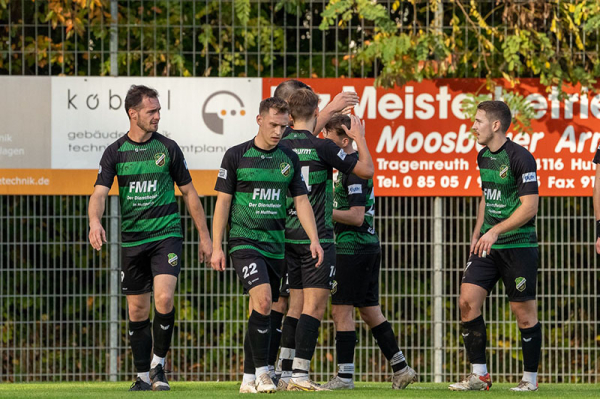
© Peter Solek
Offensive and defensive tactics in soccer
There are numerous playing systems in soccer. Most people interested in soccer have heard of the famous 4-2-3-1 or the 4-3-3. But what exactly is an offensive or defensive soccer team? Every soccer team follows offensive and defensive strategies or tactics in a soccer match, which are supposed to prevent opponent's goals and encourage scoring own goals. For this purpose, soccer coaches tune their teams to game ideas and systems of play that can be interpreted both offensively and defensively. In this article we will introduce you to the defensive and offensive tactics in soccer in detail.
What is tactics in soccer?
Tactics in soccer describe a stylistic device or approach for an individual player, a group of players, or the entire team. Regardless of the part of the team to which soccer tactics refer, a distinction is always made between offensive tactics (in possession of the ball) and defensive tactics (without the ball). Soccer tactics basically pursue the goal of putting the opponent in pressure situations more often and thus provoking more mistakes than in their own ranks. Let's first take a look at what individual and group soccer tactics are on offense and defense, using a few examples.
Examples of offensive soccer tactics
Individual tactical instruction offensive: e.g., 1 vs. 1 dribbling, free running, offering.
Group tactics offensive: e.g. double pass, play over third, steep clap game
Examples of defensive soccer tactics
Individual tactical instruction defensive: e.g. duel to win the ball, run into spaces
Group tactics defensively: e.g. create space pressure, run-up
Before we look at team tactics in more detail, it is important to consider individual and group tactics on offense and defense. These are crucial and decisive for team tactical success. Do I want the winger to dribble as often as possible in the final third of the attack, or should the defensive chain be outplayed with deep passes (double passes)? Do I want to act predominantly man-oriented against the ball or should space pressure be generated in principle? The selection of group and individual tactical instructions inspires or inhibits the execution of team tactical measures. This applies to both the offense and the defense.
The four phases of play in a soccer game
You are probably familiar with statements such as "the running was not good enough today", "the division of space was not good enough" or "the second balls went to the opponent" from coach interviews after soccer matches. What sounds like empty phrases is actually a description of team mistakes in decisive phases of the game. A soccer match consists of the following four phases:
1. playing against the ball: the opponent is in possession of the ball and the own team tries to win the ball in a certain way.
2. Playing with the ball: The own team is in possession of the ball and tries to build up the game and create scoring chances.
3. Switching offensive: The offensive switching game describes exactly the moment of winning the ball.
4.Switching defensively: The defensive switching game describes exactly the moment when the ball is lost.
From these four phases of the game, the following questions arise for the team tactical approach in soccer, which the coach should answer for his team:
1. Playing against the ball: Where should the ball ideally be won? Should the team win the ball early at the opponent's sixteenth to have a short way to the opponent's goal after winning the ball? Or should the ball be won in the team's own sixteen so that the team can quickly counter an advanced and disorganized opponent?
2. Playing with the ball: What is the distribution of space in the build-up to the game and what are the running routes? Should the team adhere to strict positional play or are the positions more freely interpreted in the build-up to the game?
3.Switching offensive: The ball has been won. What do we do now? Do we, as a team, immediately look for the deep pass or do we prefer to play across and secure the ball?
4. Switching defensively: Your own team has lost the ball. What now? Does the team as a group or as a whole immediately put the opponent under pressure or does the team drop behind the ball as a team?
The four phases of play and the resulting questions show that there is a high degree of complexity associated with a tactical approach. There are individual, group and team game ideas that harmonize with each other. And there are those that exclude certain styles of play and tactics from each other.
Example: If you want to win the ball early (attack pressing), it is difficult to play man-to-man in midfield. A space defense is then required here.
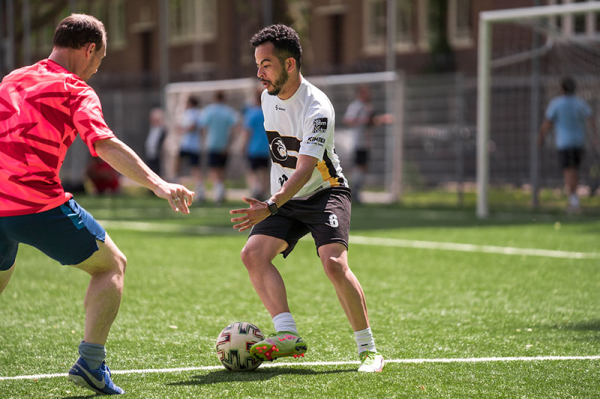
Offensive tactics in soccer explained
Offensive tactics in soccer consists of only two components:
1. the game structure and
2. the creation and exploitation of scoring opportunities.
There are two variants of the game structure, which are used predominantly or in a balanced way:
1. Build up play via the wing or
2.Build-up of play via the center.
The game structure as an offensive soccer tactic
When it comes to game structure, there are of course different components and approaches that make the soccer game look different from team to team. If you study the build-up of the game more intensively, you will realize that soccer teams have different spatial divisions and positional play. How many players do I position on the wing and in the center? And which players occupy which half-spaces on the field during the build-up of play? At this point, for example, there are strict positional instructions that are more predictable for the opponent, but are considered safer for your own team.
When does the build-up of play end or when does the creation of scoring opportunities begin?
Scholars argue about this question. Many soccer instructors believe that the buildup of play ends only in the opponent's final third, and thus the creation of scoring chances begins. Other soccer experts, on the other hand, are of the opinion that there is an intermediate phase in the midfield area that is neither part of the build-up to the game nor the creation of goal-scoring chances. Certainly, both sides are right somewhere - in this article, however, we will focus on the first and simpler variant: the build-up of play ends in the opponent's final third.
The creation and exploitation of scoring opportunities as an offensive soccer tactic
Basically, creating a goal-scoring opportunity means trying to get behind the opponent's back four. This is independent of the height of the opponent's four-man backline. There are also two main variants for creating and exploiting scoring chances:
1. Creating scoring opportunities on the wing.
2. Creating scoring opportunities through the center.
At this point, two different game situations arise in a soccer match for your own team:
1.Creating scoring chances against an organized, mostly deep opponent.
2. Creating scoring chances against a disorganized, mostly counterattack-prone opponent.
In order to outplay the opponent's defense, the team in possession of the ball needs different components. On the one hand, certain running routes (without the ball) of the players in the game play a role. In order for the deep pass or the pass into the interface to create danger or find a taker, the teammate without the ball must recognize and run into open spaces, interfaces and positional errors of the opponent. Running routes in professional soccer are rehearsed and basically team-specific.
Passing combinations (which are accompanied by rehearsed running routes) are also rehearsed in training. Passing against an organized opponent involves certain variations, such as the steep-clap combination or playing through the third. The goal against an organized opponent is to pull apart the opponent's defensive lines to open up gaps. When creating scoring chances against disorganized opponents, counter-attacking is a good way to play. When counter-attacking, the team's goal is to immediately look for the pass in depth (behind the chain) after winning the ball and to finish the goal within a few seconds.
When is an opponent disorganized?
The opponent is considered disorganized immediately after losing the ball. When the team is in possession of the ball, most of the players are involved in offensive tasks. If the team suddenly loses the ball, it takes a few seconds for the team to regain a basic order. These seconds must be exploited in counterattacking play.
Defensive tactics in soccer explained
Defensive soccer describes the approach against the ball, i.e. when the opponent has possession of the ball. At this point, there are basically four different approaches, which can vary during the game, especially among professionals:
1. Attack pressing
2. Midfield pressing
3. Defensive pressing
4. Deep defense
Except for deep defending, all defensive tactical variants end with the word "pressing". The term comes from English and means pressure play. And the term also describes the goal of a defensive tactic: to put the opponent under team pressure and force him to make mistakes. The mistakes result in ball losses, which are to be used for the own offensive game idea. Apart from deep defending, in modern soccer pressing involves at least doubling the opponent in possession of the ball. This means that at least two players put the ball possessor under pressure. To ensure that no opponent is left free during the constant doubling in an 11 vs. 11, space pressure is first achieved via rehearsed running routes. The opponent is thus "pushed in" to a defined spot on the pitch (center or wing) and put outnumbered. The resulting space pressure causes the player in possession of the ball to attempt an uncontrolled pass or dribble due to a lack of time and the long distance to the free teammate. This results in a potential loss of the ball, which can be used to create your own scoring opportunities.

The attack pressing: advantages and disadvantages
In attack pressing, the soccer team wants to win the ball as early or as high as possible. This means that the opposing goalkeeper and the opposing back four are to be disturbed and put under pressure already during the build-up of play. The opponents are therefore already attacked during the build-up of play in their own sixteen.
Advantages:
- Immediate ball capture in front of the opponent's goal - the distance to be bridged until the goal is scored is very short.
- When the ball is won, the opponent's back four is disorganized.
- The opponent plays many uncontrolled passes (long balls), which results in more easy ball wins.
- The opponent is permanently under pressure and gets no game flow or ball security.
Disadvantages:
- Attack pressing is very power and run intensive and usually cannot be played over 90 minutes.
- The own defense is very high and can be easily overplayed with long balls.
- If the attacking pressing is overplayed flat or high, the gaps are very large and easy to play into.
- Attacking pressing can be stopped very easily with a long ball or a long goalie drive.
The midfield pressing: advantages and disadvantages
In midfield pressing, soccer coaches distinguish between high midfield pressing (5-10 meters above the center line) and deep midfield pressing (5-10 meters behind the center line). In this defensive tactic, the own team is much more compact, so that the opponent has a very hard time to combine through the midfield or to find play-off stations. With this tactic, the back four and the goalkeeper are not disturbed during the build-up of play. Midfield pressing also tries to force the opponent into a certain space and put him outnumbered. Either the ball is directed to the outside defenders so that they are outnumbered on the wing and can at best play a back pass to their own goalkeeper, or a pass is forced into the center of midfield, whereupon the pass recipient is also put under pressure in 2 vs. 1 or 3 vs. 1.
Advantages:
- The own team stands compact - it is difficult for the opponent to find flat passing combinations.
- When the ball is won, the opponent is disorganized and there is a large free space to play in.
- Midfield pressing allows a mix of man-to-man and space coverage. Strong opponents can thus be taken out of the game by man-to-man coverage.
Disadvantages:
- There is always a space between your own goal and the back four. Chip balls over the defense can cause a lot of danger. It takes a brave goalkeeper who plays along to defend such balls.
- If the space pressure is not achieved by wrong shifting, the opponent has it very easy to combine the midfield.
The defensive pressing: advantages and disadvantages
In defensive pressing, the team stands deep in its own half and allows the opposing team to combine until a few meters in front of the sixteenth. Only then is the opponent put under pressure through active shifting. The goal is to close the center and direct the passes to the opposing outfield players. These can then be outnumbered by targeted or active shifting on the outer lane. It can also be that center players should run forward in order to be played with their backs to the goal so that a ball is won in the center. Important for defensive pressing: Active shifting and doubling! If you want to play very defensive soccer, you should choose defensive pressing as a method of winning the ball.
Advantages:
- Our own team is very compact. The opponent has hardly any opportunities to create scoring chances.
- The opponent has to move up wide, which favors their own counterattack when the ball is lost.
- The running intensity is kept within limits.
Disadvantages:
- The own team is mainly reacting and not acting.
- The own team has to cover a long distance when winning the ball (about 60-70 meters).
- The own team has clearly less ball possession and is therefore not game-dominating.
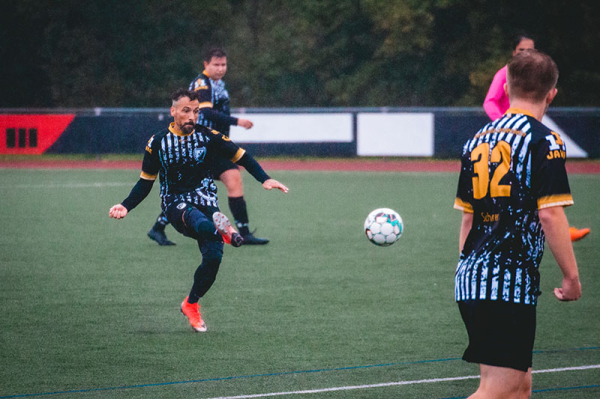
The deep defense: Advantages and disadvantages
The most important thing is that deep defending is rarely seen in modern soccer. Here, the defense condenses in its own sixteen and the team permanently tries to close all gaps and to win the ball by minimal shifting. Closing all gaps in a man-oriented manner forces the opponent to take a high dribbling and passing risk. This results in many misplaced passes and balls.
Advantages:
- The extreme compactness tires the opponent, especially mentally.
- Deep defending is less run-intensive.
- When the ball is won, the opponent is extremely far advanced.
Disadvantages:
- Deep defending is very passive or destructive.
- It requires an enormously high tactical understanding of one's players.
- The own ball actions are very low and have to be perfect to provide a scoring threat.
What is the best soccer tactics?
It is not possible to make a general statement about the best soccer tactics. The best soccer tactic is the one that is successful - that is, the one that allows few goals to be conceded and creates many chances to score. For all tactics in soccer, players must have specific skills. The best soccer tactic is therefore also dependent on the available squad. Example: If you only have very slow and immobile central defenders, you should stand tall with the back four as little as possible, because the central defenders too often lose out on long balls when sprinting. Instead of attacking pressing, a midfield or defensive pressing should be chosen in such cases.
You want to design your own soccer jersey? Then visit our website and create your individual soccer jersey for you and your team!
- Version2.3.6
- UpdateSep 09, 2024
- DeveloperPlayshore SL
- CategoryRacing & Sports
- Requires AndroidAndroid 6+
- Downloads4M+
- Package Namecom.generagames.soccer.royale.football.pvp.online
- Signaturea94a491376fffb6f66fce5f6533cf196
- Available on
- ReportFlag as inappropriate
-
NameSizeDownload
-
156.10 MB
-
156.80 MB
-
156.12 MB


![Soccer Royale Android Gameplay [60fps]](https://image.aiting.com/s1/1b/2e/3942eaf1c709489f2e329d4e4be66781.jpg)

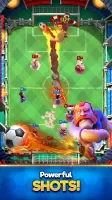






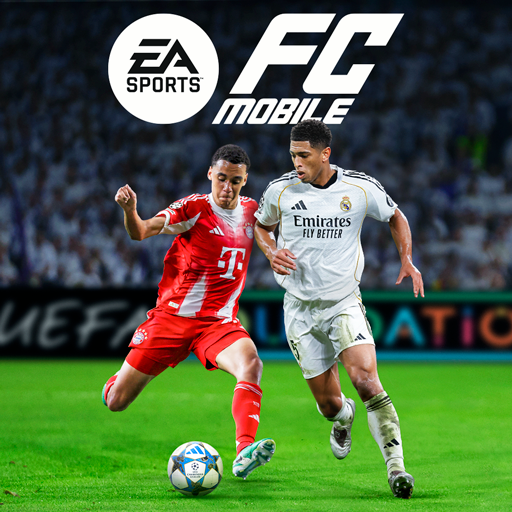














well designed game mechanics
UI after clah royale making it easier
Gameplay is complicated
Fiddly controls